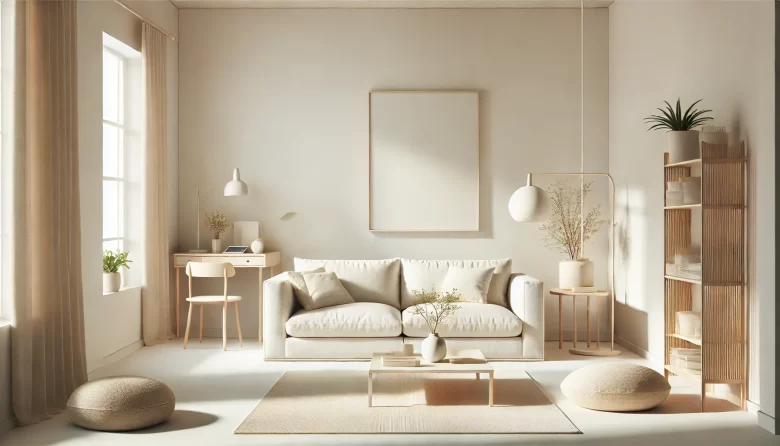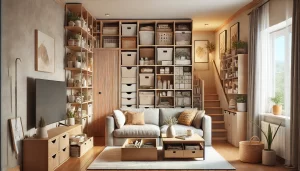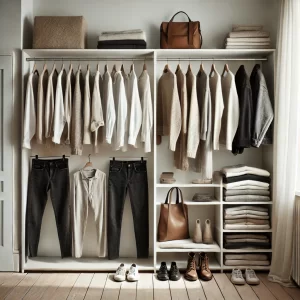Introduction
Minimalism is a lifestyle choice that focuses on living with only what is truly necessary and meaningful. In today’s fast-paced, consumer-driven society, where the pursuit of more seems endless, minimalism offers a refreshing alternative. It’s about shedding the excess—whether it’s material possessions, commitments, or distractions—to create space for the things that truly matter. As people increasingly seek ways to declutter their lives, minimalism has gained popularity as a path to greater peace, clarity, and fulfillment.
Living with fewer possessions doesn’t mean sacrificing comfort or style, but rather prioritizing what is most important and useful in your life. This could mean trimming down your wardrobe, decluttering your kitchen, or simplifying your living room. Specifically, the idea of organizing your home with less than 100 items challenges us to carefully evaluate what we truly need. By limiting ourselves to fewer possessions, we’re encouraged to make intentional choices about the things we surround ourselves with, ultimately leading to a more purposeful and organized environment.
The goal of this article is to help you understand how reducing your possessions to the essentials can bring a sense of clarity and calm to your home. By focusing on what truly adds value and serves a purpose, you can create an environment that is less chaotic, more functional, and free of unnecessary clutter. Organizing your space with less than 100 items isn’t about deprivation—it’s about living intentionally and enjoying the freedom that comes with owning only what you truly need.
The Minimalist Approach to Home Organization
Understanding the Essentials:
The idea of what constitutes an “essential” item can vary greatly from person to person. For some, an essential item might be a piece of furniture that supports their daily activities, while for others, it could be a book that inspires them. To determine what is truly essential in your life, it’s important to think about what items add the most value, either practically or emotionally. Essentials should contribute to your well-being, functionality, and overall happiness. The key is to evaluate each item based on its role in your life—does it serve a purpose, or is it simply taking up space?
Why Less is More:
One of the main principles of minimalism is the idea that less is more. By reducing the number of items in your home, you free up mental and physical space. Owning fewer things means less time spent maintaining, organizing, and cleaning. It allows you to focus more on the things that truly matter, like relationships, hobbies, or personal growth. Additionally, less clutter means fewer distractions and a clearer mind, allowing you to live more intentionally. Minimalism encourages quality over quantity, helping you curate items that bring joy and utility rather than overwhelming you with choices or excess.
Psychological Impact:
The psychological benefits of simplifying your space are significant. A cluttered home can contribute to feelings of stress, anxiety, and even depression. When we hold onto too many possessions, it can feel like we’re weighed down by them. Simplifying your home can lead to emotional and mental relief. By reducing clutter, you create an environment that promotes peace, focus, and relaxation. The act of decluttering can also foster a sense of accomplishment and control, leading to improved mental well-being and a positive outlook on life.
How to Assess What’s Essential
Inventory Your Items:
The first step in determining what’s essential is to take stock of everything you own. Start by dividing your belongings into categories such as clothing, kitchenware, furniture, electronics, and sentimental items. Go through each category and assess each item individually. This can be a daunting task, but it’s an important step in understanding how much you truly own. As you go through your possessions, ask yourself: “Do I use this often? Does this item add value to my life? Is it truly necessary?” This inventory will serve as the foundation for your decluttering process.
The 80/20 Rule:
A helpful principle to apply when assessing what to keep is the 80/20 rule. This rule suggests that 80% of your usage comes from just 20% of your possessions. Think about the clothes you wear, the kitchen gadgets you use, or the furniture you actually sit on. In most cases, there are a few key items that you use regularly, while the rest sit unused or underused. By applying this rule, you can begin to identify which items are used consistently and which ones are simply taking up space. Letting go of these underused items will help you streamline your home and focus only on the essentials.
Ask Key Questions:
To help you further narrow down what’s truly essential, ask yourself a few important questions as you evaluate each item:
Do I use this regularly? If an item hasn’t been used in months or even years, it might not be necessary.
Does this item serve multiple purposes? Items that can serve more than one function are often more valuable and essential.
Does it bring me joy or add value to my life? This question, made popular by Marie Kondo, helps you determine whether an item has emotional or practical significance.
Would I miss this if it were gone? Sometimes, it’s easier to part with something when you realize it doesn’t truly contribute to your life.
By using these questions as a guide, you can make more informed decisions about what stays and what goes, ensuring that only the truly essential items remain in your home.
Decluttering Your Home in Phases
Clothing & Personal Items
The first area to tackle when decluttering is often your wardrobe. Clothing tends to accumulate over time, and many items are rarely worn. To minimize your wardrobe to only the essentials, start by evaluating each item based on its practicality, versatility, and frequency of use. Consider adopting the concept of a capsule wardrobe, which is a collection of essential clothing pieces that can be mixed and matched to create a variety of outfits. Focus on high-quality, versatile items that can be worn for multiple occasions. This method helps you streamline your wardrobe and ensures that you’re only holding onto pieces that you truly wear and enjoy. Remember, the goal is to own fewer, better pieces rather than cluttering your closet with items that don’t serve you.
Kitchen & Dining Essentials
Next, focus on your kitchen. Many kitchens are filled with gadgets, cookware, and dining tools that we rarely use. Begin by assessing each item in your kitchen and asking if it serves a clear, practical purpose. Eliminate duplicate items and gadgets that only perform one task. Consider keeping only essential kitchenware like a good set of knives, a few versatile pans, and basic utensils. Opt for multi-use items, such as a cast iron skillet that can be used for frying, baking, and grilling. You might also want to streamline your dining tools to the basics—plates, glasses, and cutlery that you use daily. The aim is to keep just what you need to cook, eat, and entertain, making your kitchen space more functional and less cluttered.
Living Spaces & Furniture
Once your clothing and kitchen are in order, it’s time to turn your attention to the living spaces and furniture. Begin by evaluating your furniture—do each of your pieces truly add value to your space? Keep only what is both functional and aesthetically pleasing. Consider the size and layout of your rooms and whether your current furniture serves your needs or overcrowds the space. A few well-chosen, multi-functional pieces can make a room feel more open and comfortable. For example, opt for a sofa bed or a storage ottoman that serves as both seating and storage. When it comes to decorative items, select only those that truly bring you joy or enhance the room’s atmosphere. Creating a functional living space with fewer, purposeful pieces will help reduce clutter and create a more serene environment.
Sentimental Items
Sentimental items can be one of the hardest categories to declutter, as they carry emotional value. However, it’s important to approach this process with mindfulness. Go through your sentimental items and keep only those that truly bring you joy or hold significant value. For example, a family heirloom or a photo album filled with cherished memories may be worth keeping, while other items—like old souvenirs or worn-out gifts—might be better off letting go. If you’re having difficulty parting with sentimental items, consider taking photos of them before discarding or donating them. This allows you to preserve the memory without holding onto the physical object. By thoughtfully curating your sentimental items, you can preserve the meaningful while freeing up space in your home.
Organizing and Storing Your Essentials
The Art of Simplicity:
Once you’ve narrowed down your possessions to just the essentials, the next step is organizing them in a way that promotes easy access and efficiency. The key to organizing your 100 items is simplicity. Start by grouping similar items together, such as books, clothing, or kitchen tools. Store frequently used items in places that are easily accessible, while less-used items can be placed in storage or less visible spots. To keep things efficient, consider using minimalist storage solutions—items that don’t overwhelm your space but make everything easy to find. Avoid over-stuffing drawers or closets; the goal is to create a streamlined, functional layout that makes your daily life easier. Whether you’re organizing your closet, kitchen, or living room, simplicity is key to maintaining a clutter-free space.
Smart Storage Solutions:
Investing in smart storage solutions is essential for keeping your essentials organized. Clear containers and labeled bins can make it easy to identify what’s inside without having to open every box. For example, in your kitchen, transparent storage containers for dry goods allow you to see exactly what you have, while labeled baskets in your closet help keep your clothing sorted by category or season. Vertical storage is another great way to maximize space, especially in small rooms. Use shelves, wall-mounted hooks, or pegboards to store items like shoes, bags, or tools. By utilizing smart storage systems, you can keep your essentials neatly organized and ensure that everything has its designated place.
Maintaining Organization:
Once you’ve successfully downsized your belongings and created an organized space, it’s important to maintain that organization. One of the best ways to prevent clutter from returning is to establish regular habits that keep your home tidy. Set aside time weekly to tidy up and put things back in their place. Make it a habit to evaluate new items before bringing them into your home—ask yourself if they serve a clear purpose and if you have room for them in your 100-item limit. It’s also helpful to periodically reassess your belongings, even after you’ve decluttered. As seasons change or your needs evolve, you may find that certain items no longer serve you. By staying mindful of your possessions and maintaining your organized systems, you can ensure that your home remains a peaceful, clutter-free sanctuary.
Embracing a Lifestyle with Less
Living Intentionally:
Living with fewer possessions encourages you to embrace a lifestyle of mindfulness and intention. When you own only the things that truly matter to you, it’s easier to focus on the activities, relationships, and experiences that enrich your life. With fewer distractions, you free up both mental and physical space, allowing you to dedicate more time to the things that bring you joy and fulfillment. This lifestyle helps you become more intentional in your choices, whether it’s how you spend your time, the people you interact with, or the activities you prioritize. As you simplify your material possessions, you start to appreciate the non-material aspects of life more deeply, such as quality time with loved ones, personal growth, and meaningful experiences.
Avoiding Consumerism:
One of the challenges of adopting a minimalist lifestyle is resisting the constant pressure of consumerism. Society often encourages us to buy more, whether it’s through advertising, sales, or social media trends. To stay disciplined and avoid accumulating unnecessary items, it’s important to develop a mindful approach to shopping. Before making a purchase, ask yourself if the item is truly essential or if it’s just a fleeting desire. Consider whether it will add lasting value to your life or simply contribute to clutter. Set limits on impulse buying, and consider adopting a “one-in, one-out” rule: for every new item you bring into your home, donate or discard something else. By becoming more conscious of your consumption habits, you can stay true to your minimalist values and avoid falling back into the cycle of accumulating things.
Incorporating Minimalism Long-term:
To maintain a minimalist lifestyle in the long term, it’s important to regularly reassess your possessions and habits. Decluttering isn’t a one-time event; it’s an ongoing process. As your life evolves, your needs and priorities may change, so it’s helpful to periodically go through your items to ensure you’re still living with only what’s essential. Regularly clearing out items that no longer serve you helps keep your home organized and aligned with your minimalist values. Additionally, cultivating mindful shopping habits is key to long-term minimalism. Practice intentional purchasing by focusing on quality over quantity, buying only what you truly need, and avoiding the temptation to shop out of habit or boredom. By consistently practicing these habits, you can sustain a minimalist lifestyle that brings long-lasting peace, freedom, and satisfaction.
Conclusion
Organizing your home with less than 100 items is not just about reducing clutter—it’s about creating a space that promotes peace, clarity, and purpose. By keeping only the essentials, you free up valuable physical space, making your home feel more open and organized. This simplicity also extends to your mental space, as fewer possessions mean fewer distractions and a clearer mind. The act of decluttering and living with less allows you to focus on what truly matters, from nurturing relationships to pursuing your passions. The joy of living with less is found in the freedom it brings—a life unburdened by excess, where you can enjoy what you have without being overwhelmed by what you don’t need.
Taking the first step towards simplifying your life can be both empowering and transformative. Start small, and remember that minimalism is a journey, not a destination. As you begin to let go of items that no longer serve you, you’ll uncover a new sense of freedom and clarity. Embrace the process and enjoy the benefits of a more organized, intentional life. By owning fewer things, you’re not giving up your happiness—rather, you’re creating space for more meaningful experiences and a greater appreciation for what you truly value. Start today, and let the freedom of living with less bring more joy into your life.




